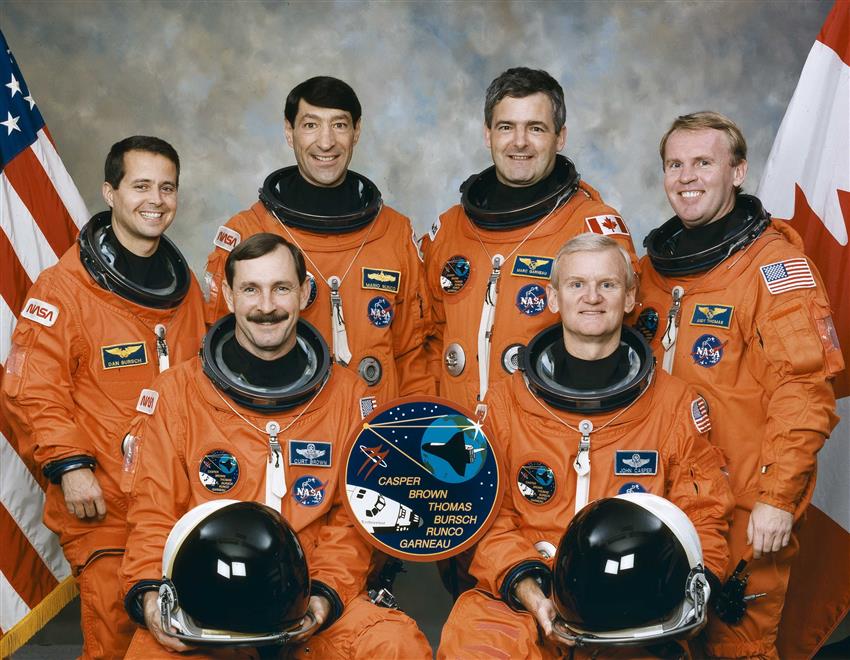Mission STS-077

Mission description

Text version
Marc Garneau's patch commemorates Canada's participation in Space Shuttle Mission STS-77. It features Space Shuttle Endeavour flying at night over an ocean that reflects a Canadian maple leaf moon. A nautical theme is the primary motif of this patch.
Endeavour is depicted in its Spartan release poise. Marc Garneau retrieved the satellite with the Canadarm. Lights in the payload bay and cabin illuminate the SPACEHAB payloads, the Canadarm, and the Spartan satellite. Canadian experiments NANO-GAS and ACTORS are illustrated by blue dots in the cargo bay.
The ocean as viewed from orbit, reflecting moonlight, depicts “where dots” that represent crystalline molecules assembling themselves into a pattern similar to the commercial float zone furnace (CFZF) logo. A star in the ocean is actually a starfish, representing an onboard Canadian experiment.
The green airglow and auroras extend above the horizon, evoking sailing vessels, a tribute to Garneau's naval experience.
Two silver and three white stars represent the total number of Canadian spaceflights up to and including this one, the fifth.
Patch STS-77. (Credit: Canadian Space Agency)
Launch
Date: May 19, 1996
Time: 06:30:00 a.m. EST
Site: Kennedy Space Center (KSC)
Landing
Date: May 29, 1996
Time: 7:09:18 a.m. EST
Site: Kennedy Space Center (KSC)
Mission duration: 10 days 0 h 40 min 10 s
Flight number: STS-77
Orbiter vehicle: Endeavour
Payloads: Commercial Float Zone Furnace (CFZF), Aquatic Research Facility (ARF), Nanocrystal Get Away Special (NANO-GAS), Atlantic Canada Thin Organic Semiconductors (ACTORS), Spacehab-4, Spartan 207/Inflatable Antenna Experiment (IAE), Technology Experiments Advancing Missions in Space (TEAMS), Brilliant Eyes Ten-Kelvin Sorption Crycooler Experiment (BETSCE), Gas Bridge Assembly (GBA), Get-Away Special Canisters (GAS), Reduced-Fill Tank Pressure Control Experiment (RFTPCE).
Canadian talent and expertise figured prominently on Shuttle Mission STS-77. Canadian Space Agency astronaut Marc Garneau celebrated his second flight into space. As well, Canadian scientific experiments onboard Space Shuttle Endeavour were part of the flight: the Commercial Float Zone Furnace (CFZF), the Aquatic Research Facility (ARF), the Nanocrystal Get Away Special nano crystal "get-away special" (NANO-GAS) and the Atlantic Canada thin organic semiconductor (ACTORS). On orbit, Marc Garneau was responsible for the CFZF.
The Canadarm deployed and retrieved Spartan: a scientific satellite that offered a simple, reusable and relatively low-cost method of collecting valuable scientific data on a wide range of scientific problems. Dr. Garneau maneuvered the Canadarm for the retrieval operations.
Canadian astronaut Chris Hadfield, who flew on Mission STS-74 only six months prior, was CAPCOM (Capsule Communicator) for STS-77, providing the only direct voice-link between Mission Control and the astronauts in the Space Shuttle.

Mission STS-77 crew
From left to right. Daniel W. Bursch, Curtis L. Brown, Mario Runco, Marc Garneau, John H. Casper and Andrew S.W. Thomas. (Credit: NASA)
- Date modified: